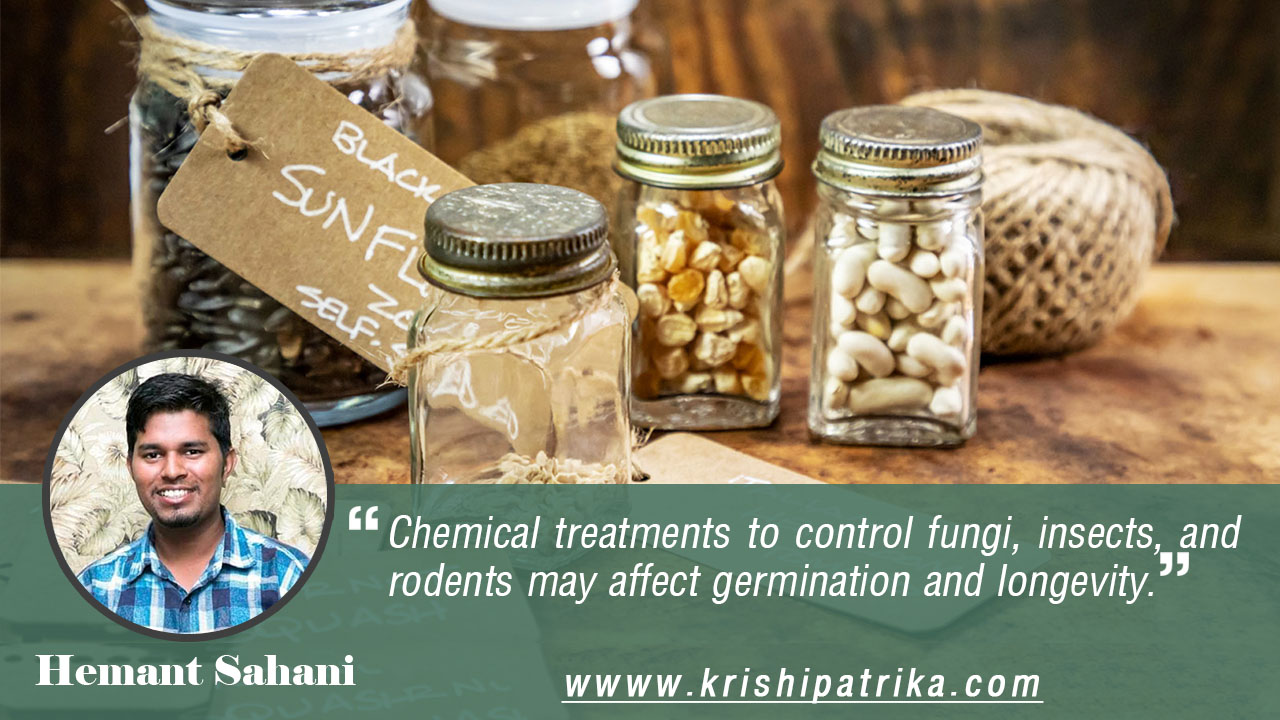
At harvest, seed contain much extraneous material, most of which is removed by cleaning. However, certain fungi, bacteria, viruses and insects are not removed, and they cause or hasten seed deterioration. In addition, chemical treatments to control fungi, insects, and rodents may affect germination and longevity. Seed borne viruses usually remain dormant in stored seeds and infect the seedling subsequent to stored seeds, usually remain quiescent because the relatively high moisture content necessary for their growth seldom occurs in commercial seed storage.
Storage Fungi :
Saprophytic and parasitic seed borne fungi include Cladosporium, Alternaria, Rhizopus spp. They remain dormant during seed storage seeds unless seed moisture content increases greatly. However, these fungi may prevent infection of grass seeds by storage fungi during the first part of the storage period certain mold (fungi), not usually present in or on seeds at harvest, can carry out their cycle on stored seeds, can destroy stored seeds, because they can grow under limited moisture condition where field fungi and other micro-organisms cannot grow. In fact, many of the storage fungi are actually osmophilic and grow best under relatively dry conditions. They can attack almost any kind of seed under favorable environmental conditions, since these molds can grow on most organic materials. Invasion of seeds by storage fungi may result in loss of viability, increase in free fatty acids, decrease in non-reducing sugars, development of mostly odors, and discoloration. Deterioration can occur in a few days when seeds are stored under unfavorable conditions.
Storage fungi are principally Aspergillus and Penicillium spp. Which commonly occur throughout the world. They are usually present in large numbers in the air and on surfaces in seed storage areas; they may be on a few seeds in a lot. They will invade and destroy seeds at 4-45 degree Celsius and 65-100 percent relative humidity. Their activity is largely determined by the physical condition, vitality, and relative humidity of the storage area. Consequently, the fungal population reflects the kind and efficiency of the post-harvesting handling, conditioning and storage environment of a seed lot. A rapid growth of fungi in stored seeds can produce so-called hot spots caused by heating.
Control of Fungal Deterioration :
Deterioration of stored seeds by fungi is controlled principally by drying the seeds to a safe moisture content prior to storage in a dry place. Most storage fungi cannot invade seeds that are in moisture equilibrium with 65% relative humidity or lower. However, some fungi are xerophytic and can invade seeds that contain only slightly too much moisture.
Because the moisture content of a seed lot represents the average of many seeds, some individual seeds may possibly contain an unsafe amount of moisture even though the moisture content of the lot is at a safe level. Seeds containing too much moisture are susceptible to invasion by storage fungi, which may then spread throughout the lot. Therefore it is extremely important to accurately measure seed moisture content. For the best results, seeds should be dried as soon as possible after harvest, then thoroughly cleaned prior to storage in an environment where they will not absorb moisture.
Insects :
Stored seeds are attacked primarily by those insects that destroy stored grain and grain products. Of the several hundred insect species associated with stored grains and seeds. Only 50 caused problems. Of that 50 only about a dozen cause serious damage, including the rice weevil, granary weevil, beetle and flat grain beetle. The weevils puncture the seed coat and destroy the endosperm, but other stored-product insects attack the embryo. In either case the germination potential is reduced or totally destroyed.
Control measures:
One should clean all seed carefully and destroy or use the cleanings, prevent seed from forming on volunteer plants, clear the field after harvest, work all chaff into the soil, and, if necessary, provide the moisture to encourage the growth of fungi present in the soil that will kill the over wintering larvae in the seeds. For some types of insects, fumigating the seeds before or during storage is also essential to good control. Methyl bromide is especially harmful to seed germination when improperly applied.
Rodents :
Rats, mice, and squirrels destroy thousands of pounds of seed each year. Much of the loss is not what these rodents eat, but what they scatter and mix.
The best control for rodents is to keep them out of seed storage areas. This can be accomplished by rodent proof construction and by eliminating such entryways as cracks and holes in walls and floors and unscreened ventilators. Cleanliness inside and outside storage areas also help to keep rodents away.
Rodent infestations can be eliminated by using traps, poison baits, or fumigation.
Fungicides and Fumigants :
Seeds treatments have long been recognized as injuring seeds in storage. The recommended treatment for many kind of seeds with mercuric chloride, liquid organic mercurial or hot water greatly reduced seed longevity. The storage of cottonseed treated with ceresin or New Improved ceresin caused no injury to the seed. Seeds of alfalfa, ladino clover, red clover treated with arasan, spergon, semesan. The seeds of beet, cabbage, carrot, egg-plant, pea pepper, and tomato with four organic mercury and four organic sulfur fungicides dusts. The seeds were then stored for up to 3 years.
The effect of several fumigants on seed viability for controlling rice weevils could be treated with up to twice the minimum lethal concentration of ethylene dichloride, isopropyl formate, tertiary butyl chloride and trichloroethylene without seriously reducing their viability. Ethylene oxide and methyl chloroacetate seriously reduced germination. White corn, yellow corn, grain sorghum with methyl bromide gas or phosphine, then planted the seed in a sandy loam soil after about 1% inches of rainfall. Methyl bromide fumigation was rather injurious and repeated fumigation with phosphine decreases field performances.









